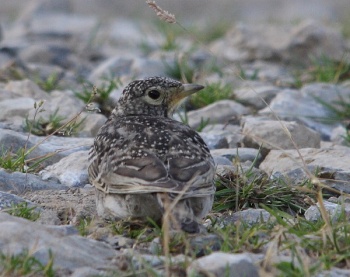Alternative name: Shore Lark
- Eremophila alpestris
Identification
Adult
- Pale or dark brown upperparts
- white underparts
- White face and throat
- mask, cap, collar, and ear tufts are black
- Tail is dark with white edges.
Sexes are similar
Juvenile
- White-spotted brown upperparts, head and face
- White eyebrow
- No ear tufts
- White underparts with faintly spotted breast
Distribution
Circumpolar, including Alaska and Canada.
Taxonomy
Subspecies[1]
- E. a. balcanica: Mountains of south-eastern Europe (Yugoslavia, Bulgaria and northern Greece)
- E. a. kumerloevei: West and central Asia Minor
- E. a. atlas: High plateaux of Morocco
- E. a. bicornis: Western Turkey (Taurus Mountains) to Lebanon and Palestine
- E. a. penicillata: Mountains of Asia Minor, the Caucasus and western Iran
- E. a. albigula: Mountains of northern and eastern Iran to Pamirs, Afghanistan and western China
- E. a. brandti: Steppes of central Asia to mountains of western Mongolia and northern China
- E. a. longirostris: North-western Himalayas
- E. a. teleschowi: Mountains of western China (extreme south-eastern Xinjiang)
- E. a. khamensis: South-western China (Kham region of western and southern Sichuan)
- E. a. przewalskii: Western China (north-western Qinghai)
- E. a. nigrifrons: Western China (Kokonor to western Gansu)
- E. a. argalea: Western China (extreme sw Xinjiang) to north-western India (Kashmir to Ladakh)
- E. a. elwesi: Western China (southern Qinghai and southern Tibet) to northern Sikkim
- E. a. enertera: West-central Baja California and coastal islands southern of Magdalena Bay
- E. a. aphrasta: North-western Mexico (Chihuahua and Durango)
- E. a. lactea: North-eastern Mexico (Coahuila)
- E. a. diaphora: North-eastern Mexico (south-eastern Coahuila to southern Tamaulipas, Hidalgo and north-eastern Puebla)
- E. a. chrysolaema: Southern Mexican Plateau (Jalisco to Michoacán, Puebla and Veracruz)
- E. a. oaxacae: Southern Mexico (east Oaxaca)
- E. a. peregrina: Eastern Andes of Colombia
- E. a. flava: Northern Palearctic region
Eastern dark Group
- E. a. hoyti: Arctic coast of North America to southern Canada; winters to northern US
- E. a. alpestris: Arctic north-eastern Canada to Newfoundland; winters coastal south-eastern US
- E. a. praticola: South-eastern Canada to central and east-central US
- E. a. giraudi: Coastal prairie region of south-eastern Texas to eastern Mexico (north-eastern Tamaulipas)
Western pale Group
- E. a. arcticola: North Alaska to mountains of British Columbia and northern Washington
- E. a. alpina: Arctic-alpine summits of north-western US (Mount Rainier and Mount St. Helens)
- E. a. leucolaema: Southern Canada to south-western US and north-western Texas; winters north-western Mexico
- E. a. enthymia: Great Plains of central Canada to central US; winters northern Mexico
- E. a. merrilli: Eastern slope of Cascades and adjacent lowlands from British Columbia to north-eastern California
- E. a. lamprochroma: South-eastern Oregon to south-western Idaho, north-eastern California and western Nevada
- E. a. utahensis: South-central Idaho to east-central Nevada and west-central Utah
- E. a. ammophila: Deserts of south-western Nevada and south-eastern California; winters north-western Mexico
- E. a. leucansiptila: Colorado Desert (south-western Nevada, western Arizona, north-eastern Baja and north-western Sonora)
- E. a. occidentalis: Northern and central Arizona to north-central New Mexico; winters northern Mexico
- 'Western rufous Group
- E. a. strigata: Humid coastal belt of south-western British Columbia and north-western US west of the Cascades
- E. a. sierrae: Mountains of north-eastern California (southern Cascades and northern Sierra Nevada)
- E. a. rubea: Central California (Sacramento Valley)
- E. a. actia: Coastal range of southern California (Humboldt Co.) to northern Baja California
- E. a. insularis: Channel Islands (off southern California)
- E. a. adusta: South Arizona (south of Tucson) to extreme south-western New Mexico and northern Sonora
Recent research indicates that this species might better be split into multiple species[3].
Habitat
Plains, fields, and beaches
Behaviour
Diet
Adults' diet includes weed and grass seeds; insects are fed to the young.
Vocalisation
<flashmp3>Eremophila alpestris (song).mp3</flashmp3>
Listen in an external program
References
- Clements, JF. 2009. The Clements Checklist of Birds of the World. 6th ed., with updates to December 2009. Ithaca: Cornell Univ. Press. ISBN 978-0801445019.
- What Bird
- Birdforum thread discussing taxonomy of Larks
Recommended Citation
- BirdForum Opus contributors. (2024) Horned Lark. In: BirdForum, the forum for wild birds and birding. Retrieved 3 May 2024 from https://www.birdforum.net/opus/Horned_Lark
External Links





